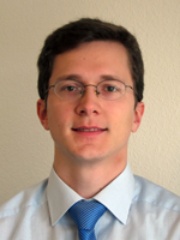
Former research assistant
E-Mail ![]() Link
Link
Address Universität Stuttgart
Pfaffenwaldring 47
70550 Stuttgart
Deutschland
Subject
Blind source separation
In a natural environment, speech signals seldom appear in a pure form, usually acoustic background noise or echoes are superimposed.
The human being overhears noises with a small noise level, can even listen specifically to a conversation partner in a vocal whirlwind (so-called cocktail party effect). On the other hand, too long echoes, as they can occur when communicating via hands-free equipment, he finds annoying.
Acoustic noises also have a negative effect on machine-language processing: the algorithms currently used for speaker recognition and speech recognition work well in speech signals recorded without interference, and the recognition rate decreases markedly in echoing, noisy environments.
In addition to the known single-channel method for acoustic noise suppression, sensor group signal processing is becoming increasingly important. The recording area of the sensor group composed of a plurality of microphones is aligned electronically to the desired speaker (beamforming). By evaluating the voice signals recorded by the sensor group, it is also possible to determine the position of the speaker in the room.
Compared to the classical sensor group processing from antenna technology, there are clearly different frame conditions in the acoustics: The speech signal is in the baseband, the localization and recording takes place in the near field of the sensors and the signal is not produced at a point source but at the mouth, larynx and ribcage.
Research at the Chair of Systems Theory and Signal Processing is currently aiming at the processing of speech signals by means of microphone sensor groups under difficult boundary conditions such as strongly reverberated rooms, poor signal-to-noise ratio or real-time requirements.
Publications
- B. Loesch and B. Yang
Performance Study for Complex Independent Component Analysis
to appear in: Blind Source Separation: Advances in Theory, Algorithms and Applications, Springer Verlag - B. Loesch and B. Yang
Cramér-Rao Bound for Circular and Noncircular Complex Independent Component Analysis
IEEE Transactions on Signal Processing 61(2): 365-379 (2013) [ local copy]
MATLAB code and data - B. Loesch and B. Yang
On the Solution of Circular and Noncircular Complex KLD-ICA in the Presence of Noise
Proc. EUSIPCO 2012, Bucarest, Romania, August 2012 - B. Loesch and B. Yang
© Cramér-Rao Bound for Circular Complex Independent Component Analysis
Proc. LVA/ICA 2012, pp. 42-49, Tel Aviv, Israel, March 2012
Note: This version corrects an error in the middle of page 7 of the paper, where the parameters eta and beta have been swapped.
Original uncorrected version - B. Loesch and B. Yang
© On the Relation between ICA and MMSE based source separation
Proc. IEEE ICASSP 2011, Prague, Czech Republic, May 2011 - B. Loesch and B. Yang
© Comparison of Different Algorithms for Acoustic Source Localization
ITG Fachtagung Sprachkommunikation, Bochum, Oktober 2010 - B. Loesch and B. Yang
© Adaptive Segmentation and Separation of Determined Convolutive Mixtures under Dynamic Conditions
LVA/ICA 2010, St. Malo, Frankreich, September 2010 - B. Loesch and B. Yang
© Blind Source Separation based on Time-Frequency Sparseness in the Presence of Spatial Aliasing
LVA/ICA 2010, St. Malo, Frankreich, September 2010 - B. Loesch and B. Yang
© A Study of ICA based DOA Estimation with Respect to Permutation Ambiguity, Scaling Ambiguity and Sensor Gain Mismatch
IWAENC 2010, Tel Aviv, Israel, August 2010 - B. Loesch, F. Nesta and Bin Yang
© On the Robustness of the Multidimensional State Coherence Transform for Solving the Permutation Problem of Frequency-Domain ICA
Proc. IEEE ICASSP 2010, Dallas, USA, March 2010 - B. Loesch, S. Uhlich and B. Yang
© Multidimensional Localization of Multiple Sound Sources using Frequency Domain ICA and an Extended State Coherence Transform
IEEE Workshop on Statistical Signal Processing 2009, Cardiff, UK, September 2009 - B. Loesch and B. Yang
© Online Blind Source Separation based on Time-Frequency Sparseness
Proc. IEEE ICASSP 2009, Taipeh, Taiwan, April 2009 - B. Loesch and B. Yang
© Source Number Estimation and Clustering for Underdetermined Blind Source Separation
Proc. Int. Workshop on Acoustic Echo and Noise Control 2008, Seattle, USA, September 2008
Further Particulars
BSS-Signals

